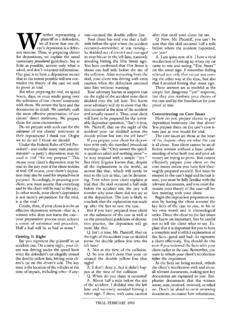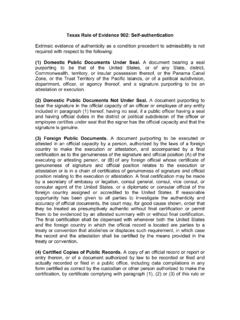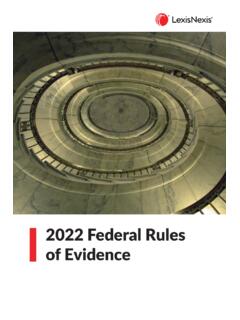Transcription of CHAPTER 9 Documentary Evidence - Shipman & Goodwin
1 9 i CHAPTER 9 Documentary Evidence Michelle L. Querijero, Esq. Shipman & Goodwin LLP, Hartford Introduction .. 9 1 Foundation Requirements .. 9 3 Identification and authentication .. 9 3 Relevance and No Undue Prejudice .. 9 4 Hearsay Exception .. 9 5 Best Evidence Rule .. 9 5 Sample Examination .. 9 5 Best Evidence Rule .. 9 8 Foundation Requirements .. 9 11 Sample Examination .. 9 12 Business Records .. 9 14 Admissibility .. 9 15 Hearsay .. 9 16 Opinion .. 9 17 Foundation .. 9 17 Sample Examination .. 9 18 Medical Bills and Records .. 9 21 State Court Admissibility .. 9 21 Federal Court Admissibility.
2 9 22 Foundation .. 9 22 A PRACTICAL GUIDE TO Evidence IN CONNECTICUT 9 ii Sample Examination .. 9 23 Public Records .. 9 24 Foundation .. 9 25 Sample Examination .. 9 27 Electronic Evidence .. 9 27 Computer-Generated Evidence .. 9 27 Electronic Messages .. 9 30 Web Pages .. 9 32 Foundation .. 9 33 Sample Examination .. 9 34 9 1 CHAPTER 9 Documentary Evidence Michelle L. Querijero, Esq. Shipman & Goodwin LLP, Hartford Scope Note This CHAPTER addresses the introduction of Documentary evi-dence. It begins with an overview of the subject and then re-views the treatment of common types of Documentary material.
3 Each of these topics is addressed through an introduction to the basic principles and applicable law, an outline of the elements required for an adequate foundation, and a sample examination. INTRODUCTION Documentary Evidence consists of any information that can be introduced at trial in the form of documents. While it is often thought of as information written down on paper, such as letters, a contract or a will, Documentary Evidence more broadly encompasses information recorded on any media on which information can be stored. Under both the Conn. Code Evid. and the Fed. R Evid., this includes information stored on computers and other media, such as e-mails, Web pages, and other data. Documentary Evidence may be offered as direct or circumstantial proof of a fact that is material to a case. For example, invoices from medical providers may be offered to prove economic damages in a personal injury case, the fact that a par-ty was warned not to destroy Evidence material to a claim may be proved with an e-mail in a spoliation case, and a contract provision and notes from its negotia-tion may prove that an individual is not a member of a shareholder class that was scheduled to receive distributions.
4 While live witness testimony may be interesting to a jury, Documentary Evidence can be particularly compelling. Documentary Evidence is not subject to an im-perfect memory, exaggeration, or vague recollections. What you see is what you get, and Documentary Evidence can establish a claim for damages or a party s statements regarding a material issue with a precision that witness testimony A PRACTICAL GUIDE TO Evidence IN CONNECTICUT 9 2 lacks. Likewise, when used to impeach a witness who has the poor judgment to lie on the stand, Documentary Evidence can be very dramatic. Documentary Evidence can, however, present challenges at trial. Despite how important the Evidence is to the case, its significance may not be immediately ob-vious to a trier of fact hearing it for the first time. Failure to make that significance clear could have a negative impact on your case, as a judge or juror may realize its import too late in the game to evaluate and connect other critical Evidence .
5 For that reason it is important to emphasize and highlight the portions of a doc-ument that are critical to your case. Once it has been admitted into Evidence , you should have the witness read the key parts to the jury. It may also be helpful to blow up excerpts of the document in a demonstrative chart or capture them on an easel pad that you fill in as the Evidence is presented. You should have the wit-ness explain the content and any terms of art that the jury may not be familiar with. You also should be sure that the witness makes the relevance and probative value of the document clear to the jury. Waiting until the jury deliberates could diminish the impact of the Evidence on your case. Finally, both the state and the federal courts have imposed duties on attorneys filing documents with the court or introducing them into Evidence .
6 Such docu-ments must have all personal identifying information redacted. Conn. Rules of Pract. 4-7; Conn. R. on E-Filing; Conn. Local R. 5. Personal identifying in-formation that must be redacted in state court includes an individual s date of birth; mother s maiden name; motor vehicle operator s license number; Social Security number; other government issued identification number except for juris, li-cense, permit or other business-related identification numbers that are otherwise made available to the public directly by any govern-ment agency or entity; health insurance identification number; or any financial account number, security code, or personal identifi-cation number. Documentary Evidence 9 3 In Federal court, an attorney filing documents must change the names of minor children to initials, limit financial account numbers and Social Security numbers to the last four digits, limit dates of birth to the year, and limit a home address to the city and state.
7 FOUNDATION REQUIREMENTS Documentary Evidence must be properly authenticated and a foundation laid before it can be admitted at trial. While there are classes of documents with special requirements, laying a foundation generally requires the following steps described in detail below: identification and authentication , relevance and no undue prejudice, hearsay exception, and the best Evidence rule. It should be noted that, at trial, you should make every effort to confer with op-posing counsel in advance to work out any foundation issues and agree whether copies may be used at trial. At the final pretrial conference, counsel customarily agree on whether exhibits can be marked as full exhibits or for identification only. The latter are then taken up via motions in limine before Evidence begins or during trial. Identification and authentication Before any Evidence , including Documentary Evidence , may be admitted, the proponent must make a preliminary showing, directly or indirectly, that the prof-fered Evidence is genuine, , that it is what it is claimed to be.
8 Fed. R. Evid. 901; Conn. Code Evid., 9-1. This is called authentication . The authentication requirement is not particularly stringent. To authenticate a document, the party seeking to admit it must provide Evidence sufficient to sup-port a finding that the proffered Evidence is what it is claimed to be, , a prima A PRACTICAL GUIDE TO Evidence IN CONNECTICUT 9 4 facie showing. Once that prima facie showing is made, the Evidence may be ad-mitted and submitted to the trier of fact, which ultimately determines its authenticity. State v. Garcia, 299 Conn. 39, 57 58 (2010); Conn. Code Evid., cmt. to 9-1. Evidence may be authenticated directly in a number of ways. For example, when a party admits to a document s existence and/or execution in the pleadings, re-sponses to interrogatories, deposition testimony, stipulation or testimony at trial, that admission will be sufficient to authenticate the document.
9 Colin C. Tait & Hon. Eliot D. Prescott, Tait s Handbook of Connecticut Evidence , (4th ed., 2008) [hereinafter Tait s Handbook]. Likewise, a witness with personal knowledge of the circumstances showing that the document is what it claims to be may offer testimony to authenticate a document. Conn. Code Evid., cmt. to ; Fed. R. Evid. 901(b)(1). Or a person familiar with another person s handwriting or voice may authenticate a handwritten document or a recording. A document also may be authenticated indirectly by circumstantial Evidence that supports its authenticity. For example, writings that use a distinct mode of speech or that reference details that no one but a specific individual would know would be authenticated as having been authored by that individual. See, , State v. John L., 85 Conn. App. 291, 302 202 (2004) (correspondence found on a computer hard drive that used a distinctive mode of expression and referenced specific details were considered authenticated and attributed to the author).
10 Likewise, a person who takes action in response to an e-mail could have the e-mail authenticated as genuine and that he or she received it. See, , Internat l Brotherhood of Elec. Workers Local 35 v. Comm n on Civil Rights, 140 Conn 537, 547 (1974) (telephone conversations were authenticated through Evidence of occurrence, subject matter, and conduct of parties). Certain documents are self-authenticating no prima facie showing of authen-ticity is required to be admissible. These include documents executed under seal, certified copies of public records, signed commercial paper, and ancient docu-ments. See Fed. R. Evid. 902; Conn. Code Evid., cmt. to 9-1; 9-2. See also Tait s Handbook, 9-12, for an extensive discussion on documents that are self-authenticating. For a discussion of the many ways by which a document may be authenticated, please see the Conn.




